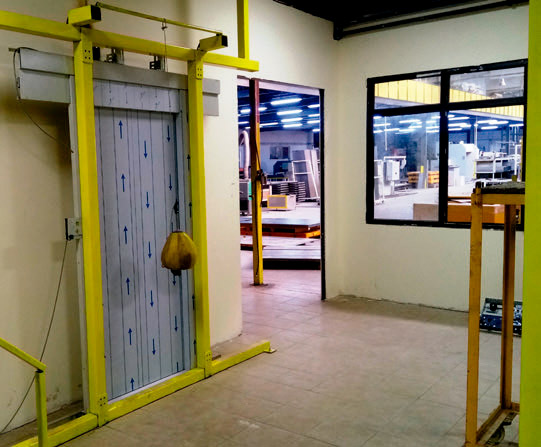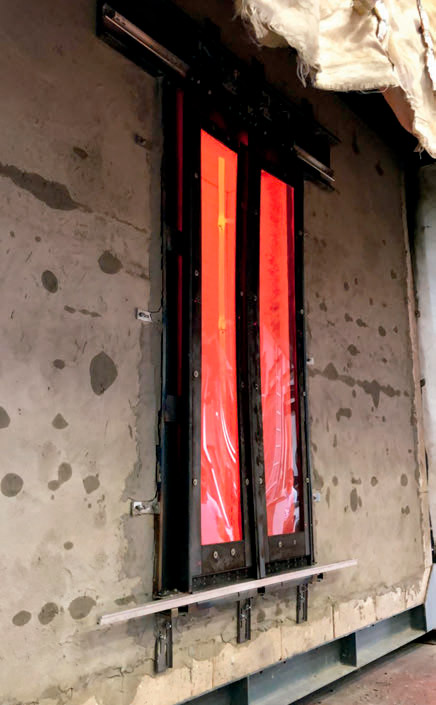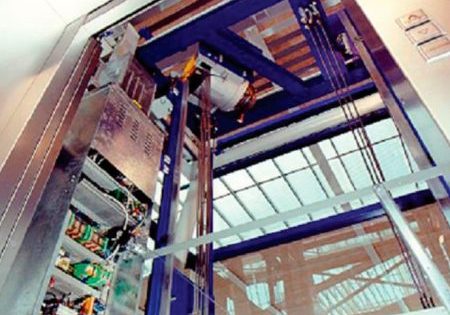Stricter regulations may be in the future, but now is a good time to review existing rules.
by Muharrem B. Çakırer
It has been said, “The rules in aviation are written in blood,” and this saying from the aircraft industry can be adapted to the elevator industry. For example, last year, a university student pushed his girlfriend in a hotel lobby in Konya, Turkey. The young girl crashed into an elevator door and fell into the shaft when the impact forced the landing door to come open, leaving her with serious injuries. When footage of the incident was released to the media, there was a public fury, and the boyfriend was arrested. So now, questions of elevator door safety are arising again. Whether this will result in stricter rules is something only time will tell. Let’s leave new codes regulating doors to the experts and, instead, take a look at the current legislation on them.
Pendulum Shock Tests
Per EN 81-20 Article 5.3.5.3.2, horizontal sliding landing and car doors shall be provided with devices for retaining the door panel(s) in position, should guiding element(s) fixed to the door panel fail. All door panels with these devices installed in their complete door assembly must withstand a pendulum shock test at striking points under the worst possible failure condition of normal guiding components. Landing doors shall be tested from the landing side, while car doors shall be tested from the car side.
Pendulum shock tests are explained in EN 81-50 Article 5.14. For metal doors, a small, short bag made of leather and filled with lead balls with an overall mass of 45 kg is released from a falling height of 800 mm (Figure 1). At the end of the test, checks shall be carried out, according to the standard, for the following:
- Loss of integrity
- Permanent deformation
- Cracks or chips
Devices for Locking Landing Doors
Per Directive 2014/33/EU, safety components to be placed on the market should first be subjected to type examination and conformity assessment by a Notified Body (NB), and a CE marking — which indicates that the product carries the minimum safety requirements in terms of health and safety of persons, safety of property and environmental and customer protection — shall be affixed on the safety component. The CE marking is a kind of “passport” that allows for the free movement of the product among European Union (EU) member countries.
Directive 2014/33/EU Annex III includes six very important elevator safety components in the high-risk group. First is “Devices for locking landing doors,” which states that the elevator shaft should not be accessible, except in emergency situations or for maintenance means; safety precautions should be taken accordingly. For instance, if a child tries to force open the door from a landing on a floor at which the car is absent, the door should not move — otherwise, death might be inevitable. The door-locking device takes on this crucial task, and to eliminate the risk of a fall down the elevator shaft, each landing door should have a locking device. The locking device has an electrical contact, in addition to its mechanical system. Although the landing door is locked mechanically, the car should not move until the electrical contact is closed. The contact is aligned with the lower edge of the lock housing and the 7-mm line on the hook. The electric safety device shall not be activated, and the car shall not move, unless the locking elements are engaged by at least 7 mm. The engagement of the locking elements shall be achieved in such a way that a force of 300 N in the opening direction of the door will not diminish the effectiveness of locking (Figure 2).
The lock shall resist, without permanent deformation or breakage that could adversely affect safety during the test laid down in EN 81-50:2018, 5.2, a minimum force at the level of the lock and in the direction of the door of:
- 1000 N, in the case of sliding doors
- 3000 N on the locking pin, in the case of hinged doors The locking action shall be effected and maintained by the action of gravity, permanent magnets or springs. In the event the spring can no longer fulfill its function, gravity shall not cause unlocking. To test this, the spring is removed, and the locking device is confirmed operable if it is closed by weight.
The locking device should carry the following information on a plate that cannot be erased or removed:
- Name of the locking device manufacturer
- Type examination number
- Type of locking device
Per Directive 2014/33/EU, safety components for lifts are subject to two types of examinations and tests carried by an NB. They are as follows:
- EU-Type Examination of safety component for lifts (Module B)
- Conformity to the type with random check (Module C2)(Figure 3)
Type examination is the control carried out to ensure suitability of the mechanical, electrical and electronic parts of the safety component, and to determine loss of effectiveness due to deterioration. The safety component is subjected to mechanical (endurance, static and dynamic) and electrical tests. If the NB confirms that the mechanical and electrical components of the locking device operate in accordance with safety and related standards, and the device carries the required specifications, an EU-Type Examination Certificate indicating that the product complies with the Directive (2014/33/EU) and EN 81-20/-50 standards is prepared. Based on this certificate, the manufacturer has the right to affix its CE marking on the Door Locking Device, and the product has freedom of movement within the EU market.
The CE marking must be attached to the safety component visibly, legibly and permanently, and the NB identification number must be located under the mark. Furthermore, every safety component must be accompanied by an EU declaration of conformity (according to Annex II of the Directive). In it, the manufacturer declares that the mentioned product has been produced in accordance with the Essential Health and Safety Requirements outlined in the Lifts Directive and assumes full responsibiliy.
Installation companies should provide pendulum test certificates, safety component type examination and conformity to type certificates, EU declaration of conformity and fire resistance certificates from the door manufacturer.
Fire Resistance
Because the elevator shaft will act as a chimney, it increases the spreading rate of fire by transmitting flames and harmful gases to other floors, creating a deadly threat for the safety of occupants. To prevent fire from spreading through the elevator shaft, the elevator landing doors must be able to withstand fire for at least half an hour. In other words, the elevator landing doors must serve as a barrier (Figures 4A and 4B).
Although there are different practices among countries, in Turkey, the legislation states, “Lift landing doors must be fireproof and smoke-proof for 30 minutes minimum, and they must also be fireproof and smoke-proof for 60 minutes minimum in buildings higher than 51.5 m.”
Fire-resistance performance of elevator doors is examined in three aspects under EN 81-58:2018. Fire tests are performed together for integrity (E), thermal insulation (EI) and radiation (EW) conditions.
E (Integrity)
The main requirement for lift door fire resistance is integrity as determined by the following criteria:
- No sustained flaming in hoistway side for more than 10 s at any time
- A leakage rate per m width of the door opening that does not exceed 3.0 m³/(min·m) after 14 min of fire
Thermal İnsulation (I)
The average surface temperature rise of the lift door shall not exceed 140°K during a defined period. For door leaf, over panel and side panel with a width ≥ 300 mm, the maximum temperature rise shall not exceed 180°K during a defined period.
For side panel width and/or over panel height of greater than 100 mm, but less than 300 mm, the maximum temperature rise of these members shall not exceed 360° K during a defined period of time.
Radiation (W)
Radiation shall not exceed the value of 15.0 kW/m² during a defined period, measured as specified in EN 1363-2.
Fire-Resistance Classification
The fire-resistance class is expressed as a combination of criteria noted above and time measured in minutes. Time shall be rounded down to the nearest fire classification period hereafter: 15, 20, 30, 45, 60, 90 or 120 min. For example, a lift landing door with E: 67 min, W: 44 min and I: 28 min is classified E 60 and/or EW 30 and/or EI 20.
Test results in terms of integrity and thermal insulation are considered to be applicable to doors of sizes different from those of the test samples (with all other constructional details being the same) within the following limitations:
- Without correction to be applied on the measured leakage rate: a similar door of lower height than the test sample, and a similar door with a door opening or an opening width in the wall equal to the one tested, within a range of ±30%
- After correcting the measured leakage rate as a function of the increase in height, as specified in EN 81-58:2018 Annex D: a similar door with increased height of up to 15%
The allowances given in both of the above can be applied together.
The fire-resistance performance of the landing door should be attached with a data label on the hoistway side of the door panel or door frame (Figure 5).
At Çağın Elevator Co., for EI 120 certification of our Crippa branded doors, we use microporous panels to keep fire insulation inside with the same construction design of E 120 panels (except for vertical reinforcements) (Figure 6).







References
[1] Lifts Directive 2014/33/EU
[2] EN 81-20:2018
[3] EN 81-50:2018
[4] EN 81-58:2018
[5] Turkey’s regulation on fire protection of buildings
Get more of Elevator World. Sign up for our free e-newsletter.









